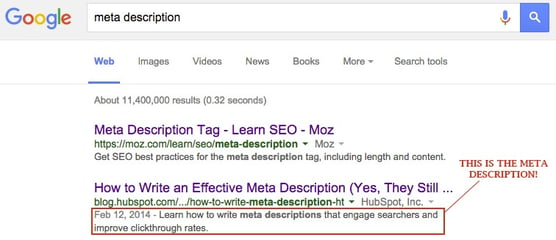St. Cloud, MN
619 W St. Germain St., Suite 214
St Cloud, MN 56301
(320) 203-4840
Green Bay, WI
520 N Broadway, Suite 270
Green Bay WI, 54303
(920) 884-1496
St. Cloud, MN
619 W St. Germain St., Suite 214
St Cloud, MN 56301
(320) 203-4840
Green Bay, WI
520 N Broadway, Suite 270
Green Bay WI, 54303
(920) 884-1496
Meta descriptions. Blegh; sounds complicated, right? A few years ago, if someone would have asked me about a meta description I would have assumed they were trying to talk nerdy to me. It sounds like code, and something that is way over my head.
Wrong.
In reality, meta descriptions can be broken down in a fairly simple way. The more content I create and the further I dig into inbound marketing methodologies, the more I realize how important meta descriptions are, and how a powerful meta description can be make or break. Here's what I’ve learned.
Experts at MOZ explain meta descriptions as “HTML attributes that provide concise explanations of the contents of web pages.” What? Let me break it down … You know when you Google something, and a list of results come up? A meta description is those couple sentences under the title that describe the search result. My friends at HubSpot describe a meta description as “the snippet of information below the link of a search result.”
Here’s a screen shot:

Basically, a meta description is what helps the searcher decide whether or not to click the link to an article or web page. A meta description helps convince or persuade readers to choose your site. Oh, and the bolded words within a meta description help note which words (keywords, in fact) match those in the search query. Not too complicated, right?
So now that we’re on the same page and you’re fully equipped with the knowledge of what a meta description is, let’s talk about whether or not you really need one. There’s no reason to reinvent the wheel here – I turned to trusted experts and dug up some meta description gold.
The short answer to “Do I need a Meta Description?” is yes. The long answer? Keep reading…
1. Increase Click Through Rates & Improve Visits from Organic Search
The percentage of clicks consistently drops off as you go further down the page, because a more relevant result is, logically, usually at the top of search engine results. So, if your result is far down at the bottom (or not even on the first page of results), you're already working shorthanded. This makes having a detailed, relevant, and eye-catching meta description that much more important. In short, the better your meta description, the more likely it is you'll have good click through rates from organic search. – via HubSpot
2. Give the Right People the Right Information at the Right Time
Google uses meta descriptions to return results when searchers use advanced search operators to match meta tag content, as well as to pull preview snippets on search result pages, but it's important to note that meta descriptions do not to influence Google's ranking algorithms for normal web search. – via MOZ
3. Increase Visits from Social
Social sharing sites like Facebook commonly use a page's description tag when the page is shared on their site. Without the meta description tag, social sharing sites may just use the first text they can find. Depending on the first text on your page, this might not create a good user experience for users encountering your content via social sharing. – via MOZ
4. Use it to “Sell” Your Content
Although the meta description itself doesn’t affect the ranking of a given web page, the side effects of a well crafted one can – well written meta description have been proven to increase click through rate, and in some instances time spent on the web page, and these metrics DO play a part in the algorithmic rankings. – via Hallam
For every blog, web page, and piece of copy we write, we follow the best practice of creating a corresponding meta description. Now that you know why (from above) – here’s the how:
To sum up the makings of a truly powerful meta descriptions, I’ll leave the final words to Google:
“Use quality descriptions. Finally, make sure your descriptions are truly descriptive. Because the meta descriptions aren’t displayed in the pages the user sees, it’s easy to let this content slide. But high-quality descriptions can be displayed in Google’s search results, and can go a long way to improving the quality and quantity of your search traffic.”
As I get older – and wiser, of course – I find there is an exception to every rule. Meta descriptions are no different. There are instances where a meta description isn’t necessarily crucial. However, as I’ve noted above, conventional logic agrees that it is generally wiser to write a good meta description for any given page. Here’s the “but”, via MOZ …
If the page is targeting long-tail traffic (three or more keywords) it can sometimes be wiser to let the engines extract the relevant text themselves. The reason is simple: when engines pull, they always display the keywords and surrounding phrases that the user has searched for. If a webmaster forces a meta description, they can detract from the relevance the engines make naturally.
It sounds tricky, but it’s pretty simple. If you have a page that lists several articles (think a blog or newsletter archive, or something like “your cart” if you’re ecommerce), it might be OK to forego the meta description. When in doubt, spend time writing an engaging sentence or two, and feel confident the right people will find the right information from you, at the right time.
We regularly share insights on how we approach marketing. Get on the list.
